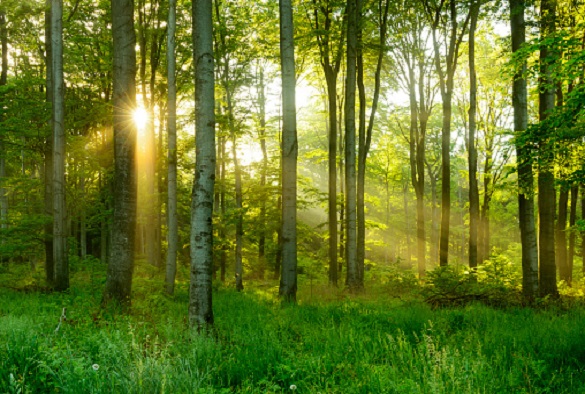
Green Natural Beech Tree Forest illuminated by Sunbeams through Trees
Research involving the University of Liverpool has revealed how natural selection can shape the long-term response of trees to climate change.
Many tree species reproduce using a strategy called masting, where they switch between years of high and low seed production. Concentrating seed production into occasional bumper years benefits the trees by increasing the efficiency of flower pollination, and by overwhelming the ability of seed-eating animals to consume all the seeds.
Trees commonly use a distinct weather signal to trigger a mast event, ensuring that all the trees growing in a forest can synchronise their reproductive efforts in the same year.
The team has previously shown that climate warming has resulted in a breakdown of masting synchrony in UK beech forests, but this new analysis demonstrates that the impacts of climate change vary remarkably between individual trees – even those growing in the same forest.
The new research shows that masting has broken down completely in some trees, but other trees have maintained the synchrony and variability of seed production. Consequently, these trees have also retained the benefits of masting – more of their flowers are pollinated, and fewer of their seeds are consumed by seed-eating insects.
Lead author Dr Michał Bogdziewicz from Adam Mickiewicz University, Poland, said: “Crucially, we have been able to identify why these individual beech trees can maintain masting despite a warming climate. They are the individual trees that show the strongest sensitivity to the weather trigger for masting, which acts like a pacemaker for bumper mast years. We found that the trees with the weakest sensitivity to the pacemaker show the masting breakdown. The trees that responded more strongly to the pacemaker have been able to maintain masting – and the benefits that masting brings”.
As disruption to masting caused by climate change varies between trees, the impacts on their ability to produce seeds also varies between trees – some lose out more than others. Dr Andrew Tanentzap, co-author from the University of Cambridge explains, “the trees that maintain masting have a higher chance of producing offspring and passing on their genes. Consequently, we could show that natural selection will act to restore masting across the forest, at least in the long-term”.
The paper also shines light on how masting can evolve in the first place. Co-author Dr Andrew Hacket-Pain, from the University of Liverpool’s School of Environmental Sciences said: “Our results reveal how natural selection can lead to the evolution of masting. The key is that individual trees with hypersensitivity to a weather trigger are the trees with the strongest masting patterns.
“As these trees tend to be the most successful, they pass on this hypersensitivity to the next generation, driving the evolution of masting. This evolutionary theory was developed in the 1970s, and it is exciting to demonstrate it empirically”.
The study involved the University of Liverpool, Adam Mickiewicz University, Poland, University of Canterbury Christchurch, New Zealand, The University of Cambridge, Keele University and Manchester Metropolitan University.
`Climate change strengthens selection for mast seeding in European beech’ was published in the journal Current Biology (doi.org/10.1016/j.cub.2020.06.056) and was supported by NERC.